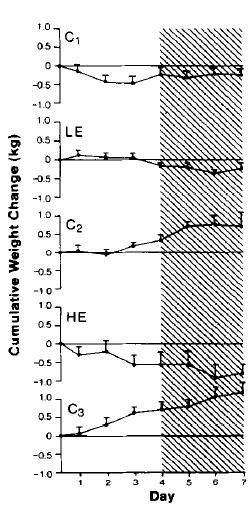In another follow-up to Pirola & Lieber, a similarly designed study where the patients were fed via nasogastric tubes an isocaloric exchange of glucose for ethanol in the context of a hypercaloric diet –> weight loss (Reinus et al., 1989).

C1-3 = control periods (hypercaloric)
LE & HE = low & high ethanol feedings
Not sure if it was intended to be ‘hypercaloric,’ but, well, they gained weight in the control periods = hypercaloric according to the Laws of Energy Balance. But they lost weight when some of those calories were alcohol, so the same number of calories were no longer hypercaloric? Still in agreement with the Laws of Energy Balance, but unfortunately not CICO. It wasn’t just ‘metabolic ward,’ it was full-on nasogastric metabolic ward.
These were metabolic ward studies. Give me a hundred other metabolic ward studies showing altered macronutrients don’t affect energy balance. Thanks. Here’s another black swan.
*Speculative end note (don’t get caught up on this): if 50% of the calories in Lieber’s diet amounted to 313 grams of carbs, and we can assume 15% protein, then they were ingesting a 35% fat diet and lost 900 grams during 7 days of 50% alcohol feeding = 129 g/d. Reinus opted for a much lower fat diet, ~12%, and his subjects lost 630 grams during 7 days of 50% alcohol feeding = 90 g/d. Admittedly, this is a stretch – it’s funny math and comparing two vastly different studies, but it indirectly confirms the rat study: alcohol calories count for less on a high fat diet than on lower fat diet. CICO is forever bollixed.
Don’t try this at home. The mechanism has been at least partially worked out (ie, MEOS), and alcohol calories only appear to “not count” in bona fide alcoholics ingesting large amounts of alcohol. But alcohol is still 7.1 kcal/g, even in bona fide alcoholics ingesting large amounts of alcohol.